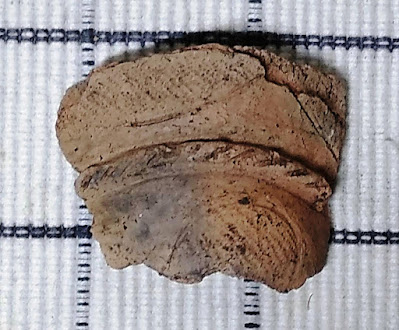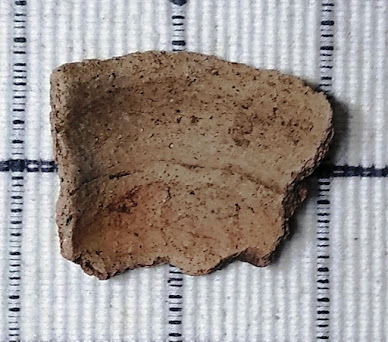187. Jōmon sherds
Jōmon
pottery (
縄文土器, Jōmon doki) is a type of ancient
earthenware pottery made
during the
Jōmon period in
Japan. The term "Jōmon"
(
縄文)
means “rope-patterned” and describes patterns often pressed into the clay. Jōmon
wares date from 10,500-300 BCE, although pottery fragments from an earlier period
that may also be Jōmon wares have been found.
The
seller had no information on these particular sherds but thought they came from
“northern Japan.”
The
clay contains minute sparkling fragments, perhaps mica or quartz. Each piece is
about 0.7 cm (1/4 in) thick.
a.
Red clay; the interior and much of the exterior are blackened, either from soot
or dirt. Weight: 122 g (4.4 oz). Dimensions: 9.5 x 13.3 (3-3/4 x 5-1/4
in). The top left shoulder and the
center of the top are the original rim on the pot; all the other edges are
broken. The vertical squiggles and the horizontal
bands were coils of clay attached to the main body. The other decorations were
incised or pressed into the clay.
b. Brown
clay, with much blackening from soot or dirt. Weight: 18 g (0.6 oz).
Dimensions: 8.7 x 4.5 cm (3-1/2 x 1-3/4 in). All the edges are broken. The
central band was formed from a coil of clay attached to the main body. The
other decorations were pressed into the clay.
c.
Tan clay, with much blackening from soot or dirt. Weight: 160 g (5.7 oz).
Dimensions: 10.2 x 11.3 cm (4 x 4-1/2 in). The upper edge is part of the
original rim; all other edges are broken. The handle(?—perhaps an arm of a
figure?), was formed from a separate strip of clay and attached to the main
body. There is no open space under the handle; there is plug of clay on the
inside of the handle closing what would normally be an opening). All the
decorations were incised into the clay.
d.
Gray clay, with reddish colors on the exterior; the interior is blackened.
Weight: 86 g (3 oz). Dimensions: 8.3 x 7.9 cm (3-1/4 x 3-1/8 in). The upper
edge is part of the original rim; all other edges are broken. The decorations
were incised into the surface.
e. Tan
clay. Weight: 160 g (5.7 oz). Dimensions: 12.7 x 11.7 cm (5 x 4-5/8 in). The upper edge is part of the original rim;
all other edges are broken. The design at the center top was from coils of
clay attached to the body of the pot. All the other decorations were incised
into the clay.
Purchased
in April 2022 from Art and Antique 28,
Gifu City, Japan.









































